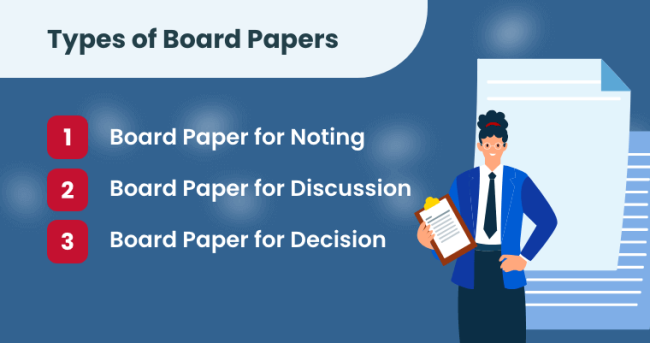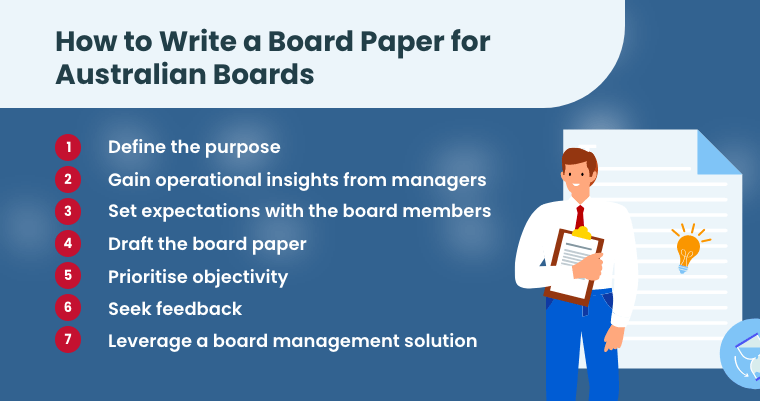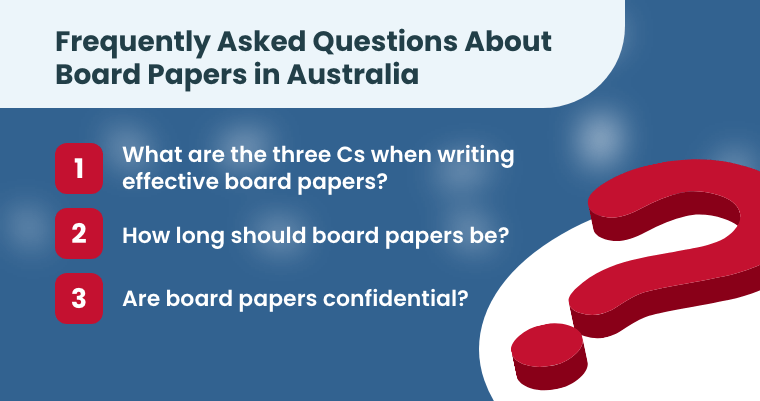Consistent and transparent information flow promotes effective collaboration between the board of directors and management. To effectively facilitate high-level information exchange, companies utilise board papers. This document conveys pertinent information to directors, highlighting operational updates, strategic insights, and recommendations.
In Australia, where corporate governance standards are robust, companies rely on board papers to provide structure in meetings. These documents assist directors in fulfilling their roles by dissecting issues, prompting timely actions and decisions that align with the company’s business goals.
This guide explores the fundamentals of board papers, including their various types, key components, and how to write a board paper. Uncover how they elevate discussions and enhance the effectiveness of Australian boards.
What are board papers?
Board papers are documents compiling all the necessary information directors need for a board meeting. This often includes the meeting agenda, reports, and proposals. They synthesise complex topics or agenda items into concise briefings, allowing directors to grasp them faster and engage in informed discussions.
Since board papers contain sensitive information, Australian boards are mandated to protect them under the Corporations Act 2001. The law underscores the importance of enforcing stringent internal policies to prevent unauthorised access, theft, damage, destruction, and falsification. Therefore, to ensure compliance and maintain the integrity of board governance, Australian boards should establish strong frameworks for the secure management and distribution of board papers.
Who creates board papers?
The management and the board secretary are the main parties involved in creating board papers.
C-suite executives build the foundation with management updates, financial reports, and key decision-making insights. The board secretary, on the other hand, leads the coordination by facilitating a smooth flow of information from gathering to compiling and distribution. If some topics require expert or deeper operational insights, the management consults with committee chairs, subject matter experts, and department heads.
Types of Board Papers

The content of board papers may vary depending on the meeting’s objectives. Discover the different formats of board papers below.
Board Paper for Noting
Management opts for board paper for noting mainly to relay updates on ongoing projects, events, or developing issues that don’t require immediate action.
Board Paper for Discussion
Similar to a board paper for noting, this format doesn’t compel boards to take action or make decisions. It initiates discussion regarding proposals or issues that need their input or consideration. Management typically includes data analysis, risk assessments, or relevant policies to provide context and guide the board during meetings.
Board Paper for Decision
A board paper for decision presents recommendations and requires the board to take formal actions or decisions. To help the board evaluate, it clearly articulates the rationale, potential impacts, and supporting evidence for each proposed action.
Key Components of a Board Paper

Even though board preference and internal policies influence how board papers are created, here are the essential components board secretaries must include.
1. Executive Summary
Begin with a high-level overview of the board paper, summarising its purpose, topics covered, recommendations, and references. Though brief, it should encapsulate the core issue to capture the board’s attention.
2. Background
The background provides an in-depth explanation of the agenda/s. It presents historical data to explain how the matter evolved, outlining relevant past decisions and actions
3. Resolution
This section presents the specific decisions the management is proposing to pass. Officially, this is a draft until the board finalises its decision. Objectively outline the proposed decisions to encourage impartial voting from the board.
4. Recommendation
Provide recommendations and back them with data-driven insights from competitor analysis, impact evaluation, and risk assessments. By articulating the rationale and potential outcomes, boards can effectively assess the impact of each recommendation.
5. Supporting Documents
Include all other documents the board needs to grasp the matters presented. This may include legal and regulatory documents, expert reports, project plans and budget proposals, minutes of relevant meetings, and policy documents.
Why are board papers essential for Australian companies?
Amid the rising challenges faced by Australian boards, board papers condense complex information into one packet, providing structure and promoting sound discussions.
Some of the key benefits of using board papers are as follows:
1. Supporting informed board discussions
Board papers are distributed in advance for board members to review. By summarising key topics and data, directors can deepen their knowledge, enabling them to contribute to discussions meaningfully and avoid poor decision-making.
2. Structuring meetings for efficient decision-making
The board can use board papers to structure the meeting flow. By presenting topics in a clear and logical order, boards can focus on high-impact deliberations rather than wasting time on disorganised debates.
3. Facilitating accurate documentation
Since recommendations are already laid out in board papers, this becomes a guide for secretaries, ensuring that minutes reflect the proposed actions and decisions. This reduces the risk of misinterpretations and enhances accountability among board members.
4. Enhancing director preparation and engagement
Board papers are fact-based, providing board members with the right level of detail without unnecessary complexity. By compiling all strategic insights in one resource, boards can effectively maximise their time to prepare discussion points. This improves the quality of deliberations and results in more productive meetings.
How to Write a Board Paper for Australian Boards

Writing board papers should be done with precision, as these documents form the basis for key decisions at the board level. Here’s how you can start your board papers.
1. Define the purpose
Begin by determining the core purpose of the meeting, whether it is for decision-making, discussion, or updating. This should be explicitly stated in the heading to guide the board’s expectations and ensure alignment throughout the preparation process, from agenda building to document gathering and resolution development.
For example, a board paper for decisions should include all insights to support informed decision-making. A paper for discussion should highlight key topics requiring board input, while a paper for noting should provide a concise summary of updates.
2. Gain operational insights from managers
Boards focus on high-level functions and may not always be fully aware of all the operational factors that could affect a particular decision. To bridge this gap, consult with managers, project heads, and other key people when writing board papers. By gathering on-the-ground insights, boards can better assess the situation, enhancing the accuracy and completeness of board papers.
3. Set expectations with the board members
Holding informal discussions with board members while writing board papers uncovers valuable insights into their expectations, concerns, and priorities. This helps management properly align meeting objectives, leading to more productive discussions and outcomes. Additionally, early discussions help identify information gaps, allowing the management to refine the board papers and improve effectiveness.
4. Draft the board paper
After gathering all pertinent insights from management, managers, and the board, outline the main topics to address. This will be the backbone of the board paper, so ensure it stays focused on the purpose.
When writing the draft, keep the tone neutral and formal. According to the Australian Institute of Company Directors (AICD), board papers must be accurate, timely, and cohesive. Support every recommendation with relevant data or analysis. More importantly, be mindful of the board’s limited time by keeping the board paper concise and free from unnecessary details.
An effective board paper starts with a clear board meeting agenda. Download our free guide on building effective board meeting agendas to start your meetings off right.
5. Prioritise objectivity
Fact-checking data is crucial for maintaining a balanced perspective. When presenting analyses or recommendations, avoid overly optimistic projections or biased language. Provide the board with rationale and objective information to empower them to make relevant and data-driven decisions.
6. Seek feedback
Engage stakeholders and ask them to review for clarity, coherence, and errors. This ensures the document is polished and fully aligned with the board’s expectations and priorities.
7. Leverage a board management solution
Creating an effective board paper involves multiple processes, including consulting, writing, and distribution. Leverage digital tools to lighten workloads and streamline the process. By adopting a board management solution, you can easily centralise workflows in one secure platform, allowing users to collaborate in real time during the writing and review process.
Frequently Asked Questions About Board Papers in Australia

Find out more about how to write a board paper in the questions below.
What are the three Cs when writing effective board papers?
Well-made board papers are clear, concise, and complete. Boards must focus on strategic issues and use their time efficiently to make well-informed decisions. To achieve that, the document should be clear with its messaging. Use straightforward language, logical headings, and visual aids for data. Second, practice brevity and use bullet points to convey discussion points effectively. Lastly, outline only key information pertinent to decision-making to avoid overwhelming the board with extraneous details.
How long should board papers be?
Board papers are usually two to three pages long. Keeping them brief helps maintain focus on high-impact matters and avoids information overload. While three-page-long is typical, their length varies depending on the subject matter. Regardless of length, board papers must effectively convey the information the board needs in meetings.
Are board papers confidential?
Yes. Board papers hold sensitive information that must remain confidential and protected to maintain compliance with the Corporations Act 2001 and the Privacy Act 1988. To guarantee data security, companies are leveraging board management software. Built with advanced security features, this solution offers fine-grained access control settings, providing greater oversight of documents and reducing the risk of breaches.
Enhance Board Security and Efficiency with Convene Board Management Software

Board papers are fundamental for facilitating informed decision-making in Australian boards. By structuring board papers properly, upholding accuracy, and adopting best practices, directors can enhance their overall efficiency and governance.
With the rise of modern board challenges, traditional methods of managing and distributing board papers slow down processes for organisational leaders. This impacts productivity and poses significant security risks.
A leading choice among global organisations, Convene is a trusted board portal solution, awarded multiple times for streamlining board management and collaboration. Within Convene, storing, distributing, and accessing board papers becomes seamless. It’s a smart, secure, and user-friendly environment that ensures that directors, secretaries, and C-suite executives receive the right information at the right time.
Get to know the advanced security and meeting management features awaiting you in Convene:
- Granular Access Control: Define precise access permissions for every user and document. Conduct meetings within and outside the board more confidently, knowing only authorised individuals can view, edit, or download board papers.
- Enterprise-Grade Cloud Hosting: Convene has partnered with Amazon Web Services (AWS) for cloud services to provide high-level security for board documents and meetings at all times.
- Secure Document Management: Eliminate traditional methods for sending meeting invitations and board papers. Convene uses encrypted channels for the safe distribution and storage of pertinent files.
- Real-Time Collaboration Tools: Facilitate dynamic discussions with live meeting tools such as live voting, annotations, and video conferencing.
Schedule a Convene demo and discover how our intuitive platform empowers boards to make informed decisions.
Jean is a Content Marketing Specialist at Convene, with over four years of experience driving brand authority and influence growth through effective B2B content strategies. Eager to deliver impactful results, Jean is a data-driven marketer who combines creativity with analytics. In her downtime, Jean relaxes by watching documentaries and mystery thrillers.





